
|
|
|
|
|
|
1,000,000 AD
Planet-sized computers dominate the Local Group; humanity's descendants are a Type 3 civilisation on the Kardashev scale
Purely biological (non-cyborg) humans are exceedingly rare now. The very few which do remain comprise only a tiny fraction of the total sentient minds in existence. Though free to come and go as they please, they have practically zero influence in any governmental systems on Earth or elsewhere, being regarded as wholly subordinate to AIs and other entities. As a species, homo sapiens has continued to evolve over time. This has led to an increase in cranial size, a near-total absence of hair, an elongation of limbs, a more robust and capable immune system, and increased lifespan.
The vast majority of humans have long since abandoned these primitive biological forms, making the transition to machines or other substrates and achieving practical immortality. The entire Milky Way galaxy has been explored by these transhumans and their sentient ships.
Faster-than-light travel is now possible using Alcubierre drives, which are compact and miniaturised enough to be found in even personal, single-occupancy vessels. These use such colossal amounts of power that they cause the fabric of space ahead of a ship to contract, while the space behind it expands. This bypasses the laws of relativity, allowing travel to even neighbouring galaxies such as M31 (Andromeda) and M33 (Triangulum).
Planet-sized computers are being constructed throughout the Local Group of galaxies, with every available resource going towards their production. All of the "dead" worlds, comets, moons and asteroids considered uninhabitable are being converted into these machines, forming a vast network millions of light years across space. Each computer is capable of instant communications with any other, regardless of distance.
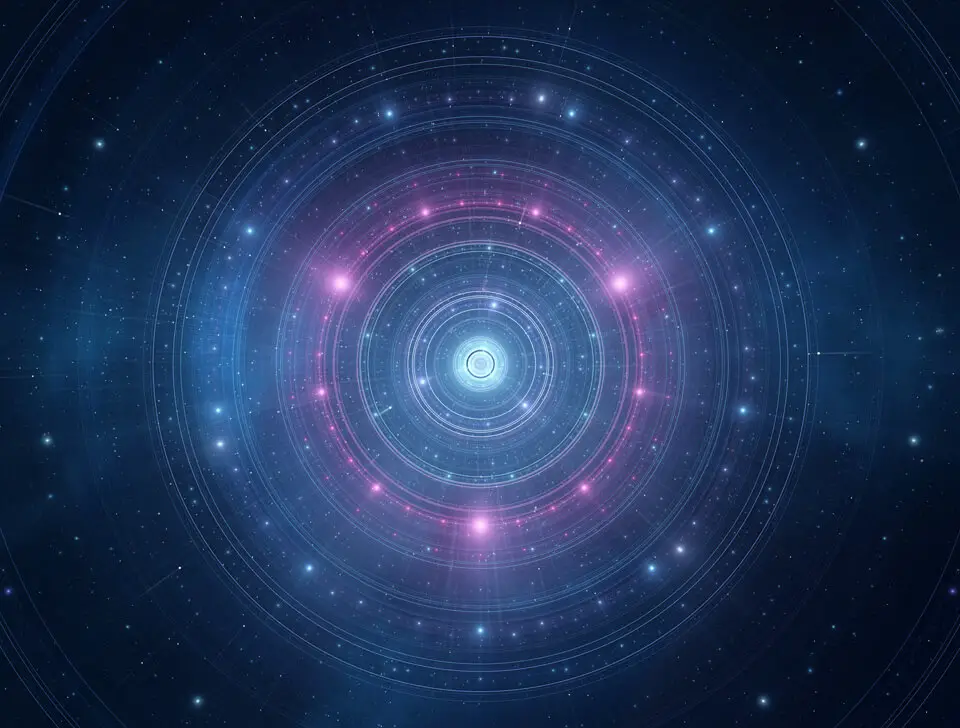
A number of alien intelligences have been contacted by now. In addition, ancient ruins have been uncovered on some worlds, indicating advanced civilisations that somehow failed or destroyed themselves in the distant past. Millions of other planets have been discovered to have ecosystems brimming with plant, animal, and other life. Most of the fauna being catalogued is small and insect-like, but some is more developed with intelligence comparable to higher mammals such as dolphins, monkeys and cats.

© Randall Mikulas | Dreamstime.com
1,400,000 AD
The Oort cloud is being disrupted by the approach of Gliese 710
The orange dwarf star, Gliese 710, is passing within 1.1 light years (70,000 AU) of the Sun. This is close enough to disrupt the Oort Cloud surrounding our solar system. A shower of comets is now heading in-system. At its closest approach, Gliese 710 will be a first-magnitude star when viewed from Earth: one of the brightest in the night sky.
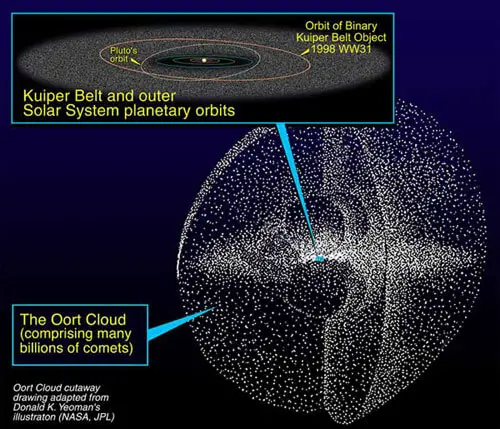
2,000,000 AD
Pioneer 10 is approaching the Aldebaran system
Pioneer 10 was the first space probe to travel through the asteroid belt and to directly observe Jupiter, which it passed by in 1973. After completing its mission, it began heading in the direction of Aldebaran – a red giant star located 65 light years away in the constellation Taurus.
The final contact with the probe was made in 2003, when a very weak signal was detected from the craft, 12 billion kilometers (7.5 billion miles) from Earth. An attempt at contact in 2006 was unsuccessful.
After travelling at roughly 2.6 AU per year, Pioneer 10 begins to approach the Aldebaran system in 2,000,000 AD.*
Attached to the probe is a pictorial message, in case of interception by extraterrestrial life. This plaque shows the nude figures of a human male and female, along with symbols that are designed to provide information about the origin of the spacecraft.
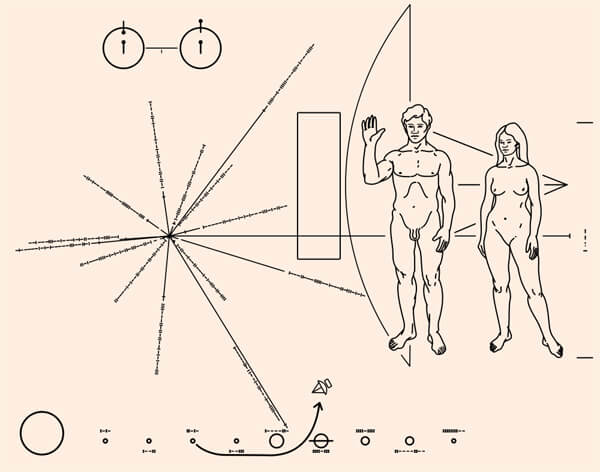
3,000,000 AD
Earth's day has been lengthened by one minute
Incremental changes in the gravitational interaction between Earth and the Moon added an extra second to Earth's day by 52,000 AD. This has increased to an extra minute by 3,000,000 AD.* It will increase to one hour by 180,000,000 AD.

4,000,000 AD
Pioneer 11 is approaching the Lambda Aquilae system
Pioneer 11 is the sister craft of Pioneer 10. Launched in 1973, it completed a successful flyby of Saturn in 1979, before heading out to interstellar space, travelling in the opposite direction of Pioneer 10. After four million years, it passes by Lambda Aquilae, a blue-white B-type main sequence dwarf star, around 125 light years from Earth.* Like its sister, Pioneer 11 carries a plaque with a message from humankind.
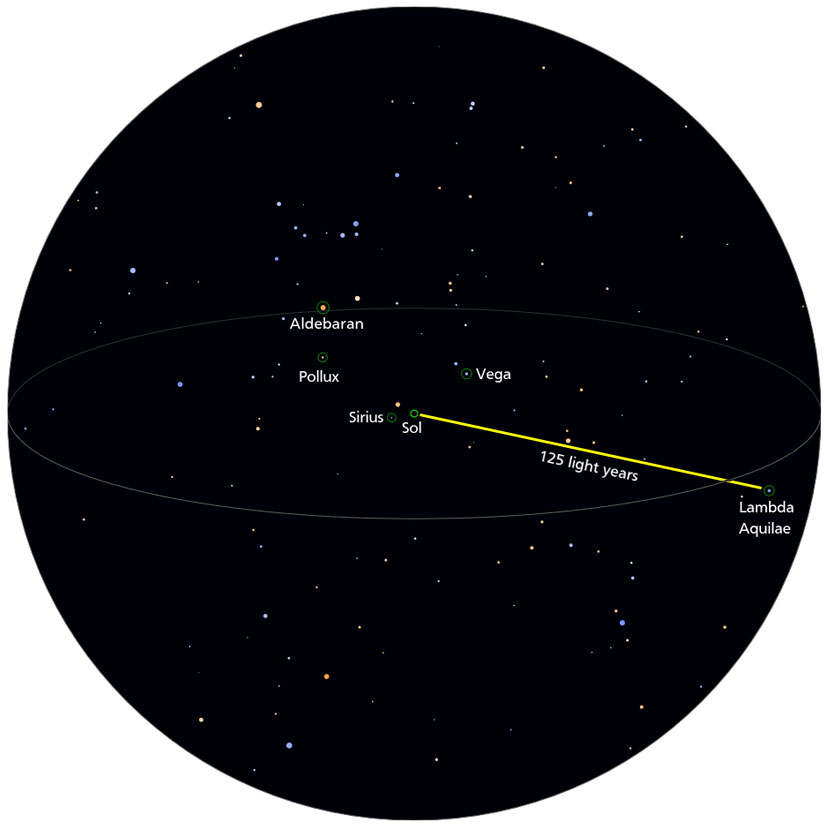
3D map of stars within 125 light years of Earth. Credit: http://www.parvarium.com/stars/
6,800,000 AD
DNA from the 21st century has completely decayed
Even if preserved under ideal storage conditions of −5°C, every molecular bond in a strand of DNA will decay after 6.8 million years. Any remaining biological samples from the 21st century which have not been recovered or digitised are now completely destroyed.*

7,200,000 AD
Mount Rushmore has eroded away
Absent human intervention, the famous faces of Presidents carved in the side of this rock formation have disappeared by now. Granite has an erosion rate of approximately one inch per 10,000 years.*

7,600,000 AD
Phobos is ripped apart by Mars' gravity
Phobos is the largest and closest of the two moons of Mars. Because its orbital period is shorter than a Martian day, tidal deceleration has been decreasing its orbital radius at the rate of about 20 metres (66 ft) per century.
By this date, it has passed the Roche limit – the distance within which a celestial body, held together only by its own gravity, will disintegrate due to a second body's tidal forces exceeding the first's gravitational self-attraction.
Phobos begins to break apart. It gradually becomes a ring system over the following 3 million years, with many of these fragments impacting upon Mars itself.*
Neptune's largest moon – Triton – will share a similar fate.
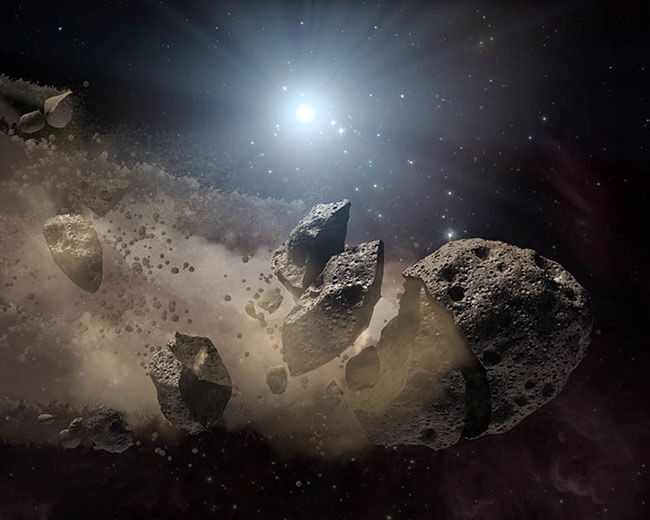
Credit: NASA
/ JPL
8,400,000 AD
LAGEOS-1 returns to Earth
Laser Geodynamics Satellites (LAGEOS) were a pair of scientific research satellites launched in the late 20th century and designed to provide an orbiting laser ranging benchmark for geodynamical studies. Each was a high density passive laser reflector in a very stable medium Earth orbit (MEO), roughly 5,900 kilometres (3,700 mi) in altitude.
These spacecraft were aluminium-covered brass spheres with diameters of 60cm and weighing approximately 400kg, covered with cube-corner retroreflectors, giving them the appearance of giant golf balls. They had no on-board sensors or electronics, and no attitude control. Measurements were made by transmitting pulsed laser beams from ground stations to the satellites. The laser beams returned to Earth after hitting the reflecting surfaces.
Due to the stability of their orbits, the LAGEOS satellites made it possible to determine positions on the Earth with ultra-high accuracy: better than one inch in thousands of miles. At the time, this made them the most precise location references available. As such, they were used for monitoring the movement of the Earth's tectonic plates, gravitational field, the "wobble" in its axis of rotation, and for determining the exact length of an Earth day.
However, these satellites would fall back to Earth eventually. LAGEOS-1 was predicted to re-enter the atmosphere in 8,400,000 AD. It contained a plaque, designed to allow future descendants of humans to view the arrangement of Earth's continents in the past, present and future.*
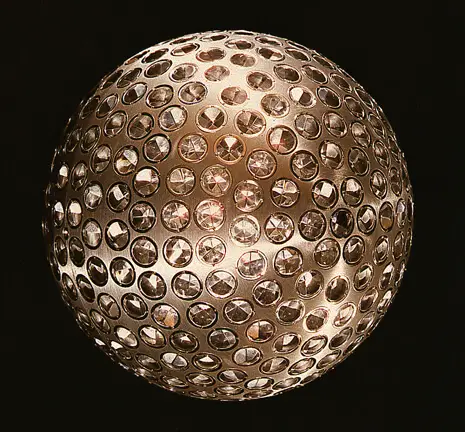
10,000,000 AD
Earth is being threatened by lethal levels of gamma radiation
T Pyxidis is a binary star system in the constellation Pyxis. It contains a sun-like star and a white dwarf. Because of the strong gravitational effect of the white dwarf, it draws matter from the other star which causes periodic thermonuclear explosions (so-called novae) to occur.
Around this time, it reaches the so-called Chandrasekhar Limit, causing it to undergo an instantaneous collapse that completely destroys the star in a Type 1a supernova. This catastrophic event releases 10 million times more energy than a typical nova explosion – the equivalent of 20 billion, billion, billion megatons of TNT.*
The system is only 3,260 light years away, close enough to destroy Earth's ozone layer and cause mass extinctions unless the planet is shielded by advanced technology.

27,000,000 AD
Smith's Cloud is colliding and merging with our Milky Way galaxy
Smith's Cloud is a gigantic, high-velocity cloud of hydrogen gas, measuring 11,000 light years in length and moving on a direct collision course with the outer spiral arms of the Milky Way. First discovered in 1963, it was found to be roughly 40,000 light years from Earth, lying outside the galactic plane and moving at hundreds of kilometres per second.
Initially, it was thought to have crossed the immense void of intergalactic space on its long journey towards the Milky Way.* Subsequent observations, however, later revealed that it had originated from another part of the Milky Way, some 70 million years previously. Like a boomerang effect, it was in the process of heading back to its galactic home.*
The cloud was predicted to reach the galactic plane in 27 million AD. By this date, it has collided and begun merging with part of the Perseus Arm, one of the major spiral arms of the Milky Way. The impact generates enormous shockwaves, triggering an intense burst of star formation – like a monstrous, slow-motion firework display. Over two million new stars are formed in that part of the galaxy, with many ending up as supernovae within a relatively short time and exploding with a billion times the brightness of our Sun.*

Credit: NASA/ESA
30,000,000 - 40,000,000 AD
At some point during this period, an asteroid 10-20 km in size comes on a direct collision course with Earth
Impacts of this size tend to happen every 100 million years or so.* The last such event occurred 65m years ago – resulting in the extinction of the dinosaurs.
If humanity or its descendants are no longer around to protect it, any remaining life on the planet may be in danger of a similar mass extinction during this time.
An impact of this scale would release around 4×1023 joules of energy, equivalent to 100 million megatons of TNT. By contrast, the most powerful man-made explosion in history, the "Tsar Bomba", had a yield of only 50 megatons.
If landing in the ocean, it would produce megatsunamis reaching thousands of feet high.
A cloud of super-heated dust, ash and steam would spread from the crater, as the impactor burrowed underground in less than a second. Excavated material and pieces of the impactor – ejected out of the atmosphere by the blast – would be heated to incandescence upon re-entry, broiling the Earth's surface and igniting global wildfires. Meanwhile, colossal shock waves would spawn global earthquakes and volcanic eruptions. The emission of dust and particles would cover the entire surface of the Earth for several years, possibly a decade, creating a harsh environment for living things to survive. The shock production of carbon dioxide caused by the destruction of carbonate rocks would trigger a sudden greenhouse effect.
Over a longer period of time, sunlight would be blocked from reaching the surface of the earth by the dust particles in the atmosphere, cooling the surface dramatically. Photosynthesis by plants would be interrupted, collapsing the entire food chain.

Credit: NASA
50,000,000 AD
The African continent merges with Europe, forming a new mountain range to rival the Himalayas
The Mediterranean no longer exists. The Red Sea, Black Sea and Caspian Sea have also disappeared. Meanwhile, the Atlantic Ocean has continued to widen, and southeast Asia is merging with Australia.
100,000,000 AD
The rings of Saturn have disappeared
The rings of Saturn were first observed by the Italian astronomer Galileo in 1610. Subsequent studies by Giovanni Cassini in 1675 confirmed that there were in fact multiple smaller rings with gaps between them. In 1789, the first moon within the ring system – Enceladus – was found by William Herschel. In 1859, James Clerk Maxwell demonstrated that the rings could not be solid or they would become unstable and break apart. He proposed that the rings must be composed of numerous small particles, all independently orbiting the gas giant. Maxwell's theory was eventually proven to be correct, through spectroscopic analysis by James Keeler in 1895.
During the 20th and early 21st centuries, space probes identified a whole series of new moons – increasing Saturn's total number of known satellites almost tenfold. Some of these objects were found to be travelling inside the gaps of the rings, clearing paths through the debris.* They ranged in size, depending on their proximity to Saturn – the farther from the planet, the larger they were. Based on these facts, and other evidence, it was believed that inner moons had initially accreted from ring particles, then moved outward, away from the planet, gradually merging with other moons on the way. This process of satellite formation was thought to have ended, as the rings were too depleted to produce more objects of significant mass. It was also calculated that most of the material had to have originated from the Kuiper Belt some 4.4 billion years previously, with smaller amounts coming from the more distant Oort Cloud and interstellar space.*
Later in the 21st century, increasingly sophisticated robots were able to investigate the rings at extreme close range, sending back pictures and video while also obtaining samples of rock and ice. This strange alien environment, measuring just 10-20m (33-66ft) in vertical thickness, eventually became a tourist destination for transhuman explorers.
These bright and beautiful rings would not last, however. Over time, they were slowly being bombarded by micrometeoroids – trillions of tiny collisions eroding their structure and darkening their appearance. Material was also being liberated by charged particles emanating from the magnetosphere, combined with gravitational influence of the moons. By 100 million AD, Saturn's rings have largely disappeared.**

The Milky Way has stabilised from an earlier collision
Our galaxy is surrounded by dozens of smaller dwarf galaxies. These will occasionally pass through the disk of the Milky Way, disrupting both it and the incoming satellite. One such collision occurred in roughly 100 million BC. This was confirmed by observations of 300,000 nearby stars, whose motions indicated a reverberation or "ringing" like a bell. The stars were found to be moving up and down at speeds of 20-30 kilometres per second while orbiting the centre of the galaxy at 220 kilometres per second.
It would take a further 100 million years (from the time of this observation) for this motion to stabilise and for the Milky Way to stop reverberating. By now, the north-south asymmetry has disappeared and the vertical motions of stars in the solar neighborhood have reverted back to their equilibrium orbits.*

150,000,000 AD
The Atlantic Ocean begins to close
The mid-Atlantic ridge is causing the Americas and Africa to move back together. Australia has fully merged with Indonesia.
180,000,000 AD
Earth has a 25 hour day
Ever since the formation of the Moon – around 4.5 billion years BC – it has receded from the Earth. In the beginning, the extremely close relationship between the two bodies created a day-night cycle of just six hours on Earth. This increased to 24 hours by the Holocene.
The gravitational interaction continued to decline, millimetre by millimetre, leading to an extra second being added to Earth's day by 52,000 AD and an extra minute by 3,000,000 AD. An extra hour has been added by 180,000,000 AD, meaning Earth now has a 25 hour day.*

225,000,000 AD
Sol completes one galactic year
By now, our Sun has completed another clockwise revolution around the galaxy – the 21st in its lifetime so far.
The Sun's orbit is slightly elliptical, with perturbations due to the galactic spiral arms and non-uniform mass distributions. In addition, the Sun oscillates up and down relative to the galactic plane, around 2.7 times per orbit.
The Sun's passage through the higher density spiral arms has coincided with mass extinctions on Earth, due to increased impact events.
The orbital speed of the Solar System around the centre of the Galaxy is approximately 251 km/s.

250,000,000 AD
A supercontinent is forming on Earth
The next Pangea – Pangea Ultima – is forming, with all of the major continents moving back together, surrounding a small ocean basin.
Our Sun is becoming noticeably hotter and brighter, raising global temperatures. Much of Earth is now covered by deserts.
600,000,000 AD
Total solar eclipses are no longer possible on Earth
Due to tidal acceleration, the distance of the Moon from the Earth has been increasing by approximately 3.8cm each year. By 600 million AD, the distance has increased by nearly 23,000 km. At the same time, the Sun has been growing in size by a significant amount.
As a result, the Moon is no longer big enough in the sky to completely cover the Sun's disk, making total eclipses impossible. This is true even when the Moon is at perigee and the Earth is at aphelion.
The reduced gravitational influence of the Moon is affecting Earth's oceans – with smaller waves and less variation in tide heights.
750,000,000 AD
The Sagittarius dwarf galaxy has been absorbed into the larger Milky Way
The Sagittarius dwarf elliptical galaxy (Sag DEG) is a tiny satellite galaxy orbiting the Milky Way. For aeons, it has been stretched and torn apart by the immense tidal forces of its neighbour. By now, it has been completely absorbed into the Milky Way.*
When first discovered, astronomers thought that Sag DEG had already reached an advanced stage of destruction. However, later observations showed that it still had coherence, as a dispersed elongated ellipse. It appeared to be moving in a roughly polar orbit around the Milky Way, reaching as close as 50,000 light years from the galactic core. Computer simulations indicated that stars ripped out from the dwarf would be spread out in a vast "stellar stream" along its path, and these were subsequently confirmed.
Sag DEG may have orbited the Milky Way as many as ten times, prior to being swallowed up. Its ability to retain some coherence, despite such strains, would indicate an unusually high level of dark matter in that galaxy.
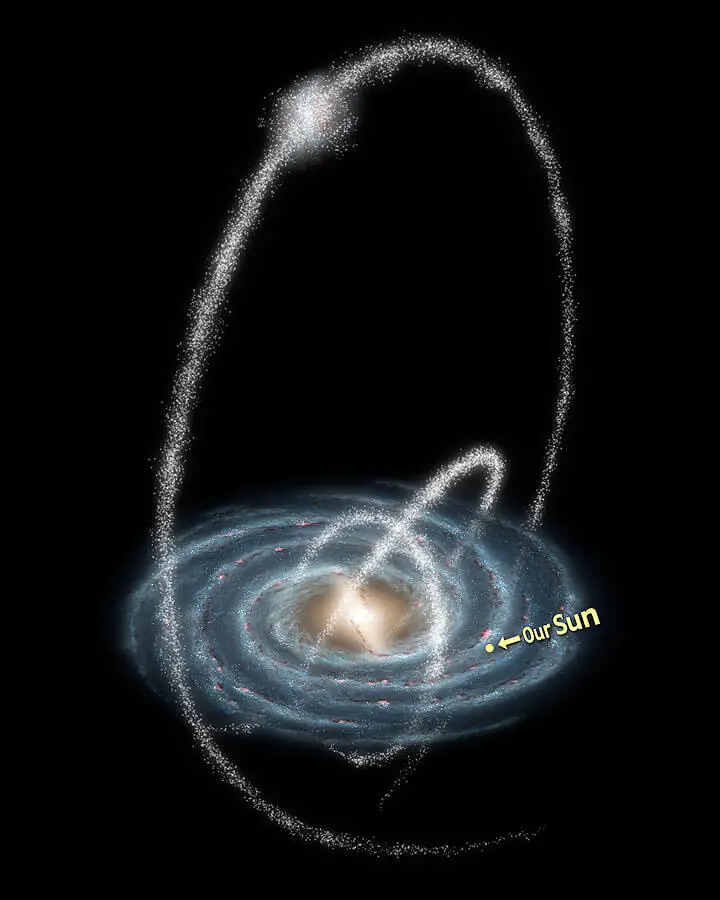
1,000,000,000 AD
Earth is becoming too hot to support liquid water
The Sun's luminosity has increased by 10%, causing Earth's surface temperatures to reach an average of 47°C (116°F).* As the seas and oceans begin to evaporate, the atmosphere is becoming laden with water vapour, creating an intense greenhouse effect. Mars is actually becoming more habitable during this time.*
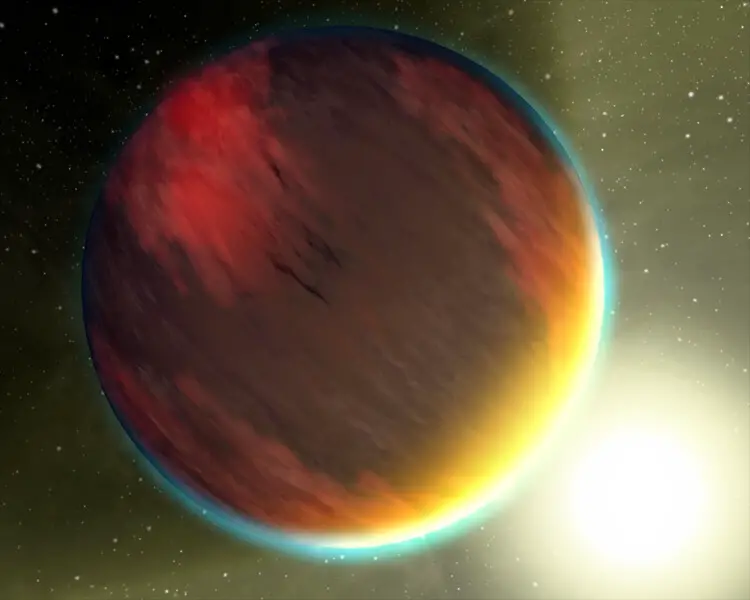
Credit: NASA/JPL-Caltech
2,400,000,000 AD
The Large Magellanic Cloud is merging with the Milky Way galaxy
The Large Magellanic Cloud (LMC) is the largest of the approximately 50 satellite galaxies known to orbit the Milky Way. Measuring around 9.86 kiloparsecs (32,200 light-years) across, it also ranks as the fourth-largest galaxy in the Local Group, after the Andromeda Galaxy (M31), Milky Way, and Triangulum Galaxy (M33). Both the LMC and its neighbour, the Small Magellanic Cloud (SMC), are the only satellite galaxies visible to the naked eye.
During a previous era, the Sagittarius Dwarf Galaxy (mid-way in size between the SMC and LMC) had been absorbed into the Milky Way. This process had been typical of the natural evolution of galaxies, in which larger galaxies often consume smaller ones.
Another such merger is now occurring* as the LMC – having been 163,000 light-years distant – is drawn in by the gravity of its parent galaxy, first through the outer halo of stars and then through the spiral arms.
This collision significantly alters the structure of the Milky Way. The LMC's 20 billion stars are added to those of the Milky Way, increasing the latter's total number by 5–10% and making its halo five times more massive. Sagittarius A*, the supermassive black hole at the centre of our galaxy, becomes much more active, eventually growing to be eight times larger. Powerful jets of high energy radiation are generated from just outside the black hole, while some star systems are ejected out of the Milky Way and into the dark void of intergalactic space.
The LMC collision, while significant, is a mere prelude to the much larger impact of the Andromeda Galaxy, some 1.4 billion years hence. This hybrid Andromeda–Milky Way galaxy will, itself, merge into the Virgo Supercluster in the more distant future.
Credit: FIRE simulation/Hopkins Research Group
3,600,000,000 AD
Triton exceeds the Roche limit of Neptune
Triton is by far the largest of the Neptunian moons, comprising 99.5% of the mass orbiting around Neptune, and the only one of the ice giant's natural satellites massive enough to be spheroidal. For aeons, tidal interactions have caused Triton's orbit to decay by several centimetres each year. By now, it is passing through the Roche limit – the distance from a celestial body within which a second celestial body, held together only by its own force of gravity, will disintegrate because the first body's tidal forces exceed the second body's gravitational self-attraction. Triton becomes more elongated, causing gigantic fissures along its surface, before the immense gravitational forces trigger a spectacular break up. The remnants will eventually form a new ring system as dramatic as that of Saturn in the distant past.*

3,800,000,000 AD
The Andromeda Galaxy has begun to collide and merge with our own Milky Way galaxy
The earliest recorded observation of Andromeda – the nearest spiral galaxy to our own – was made in the year 964. Persian astronomer, Abd al-Rahman al-Sufi, described the object as a "small cloud". The first description based on telescopic observation was given by German astronomer Simon Marius in 1612. Charles Messier catalogued it as M31 in 1764 and incorrectly credited Marius as the discoverer, unaware of Al Sufi's earlier work. The first photographs were taken in 1887 by Isaac Roberts, and the first radio maps were produced in the 1950s by John Baldwin.
Later observations confirmed the size, distance and velocity of Andromeda. It was found to be the largest galaxy in the Local Group, with over a trillion stars – at least twice as many as the Milky Way. It was 2.5 million light years from Earth and moving at 250,000 miles per hour. It was also found to be on a collision course: heading directly towards the Milky Way.
By 3,800,000,000 AD, a full-scale merger is underway.** A single, giant elliptical galaxy will eventually be formed. Stars and planets within each galaxy almost never collide, however, as galaxies are extremely diffuse. Such mergers are in fact relatively common. Andromeda, for example, collided with at least one other galaxy in the distant past.
Click to view animation
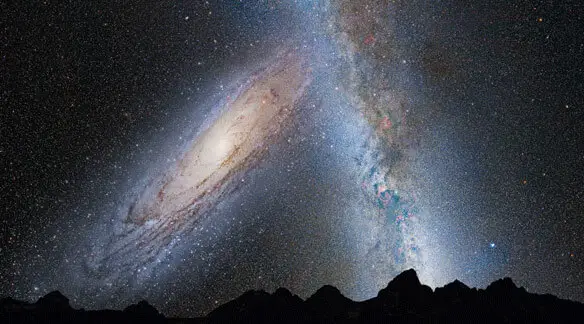
Credit: NASA; ESA; Z. Levay and R. van der Marel, STScI; T. Hallas, and A. Mellinger
5,000,000,000 AD
Sol is a red giant
The inner planets of the Solar System have been destroyed and absorbed by the ballooning Sun. Its radius has now expanded by over 200 times.
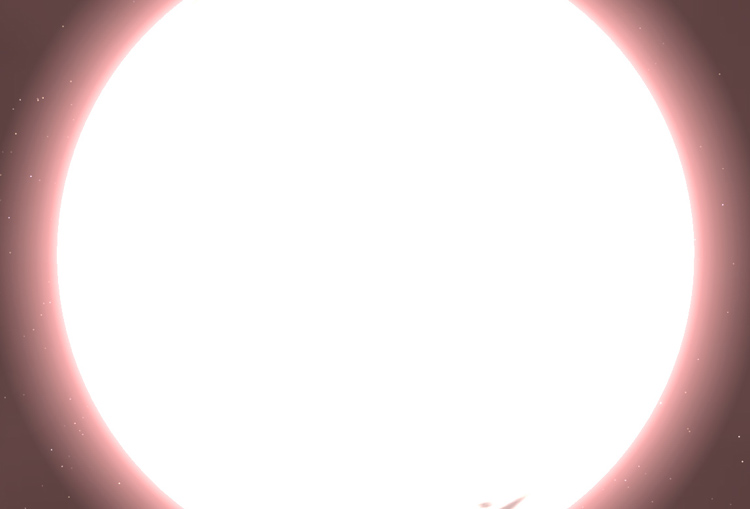
12,000,000,000 AD
Sol is shrinking to become a black dwarf
Most of the Sun's mass has been ejected, forming a planetary nebula. Having ended its main sequence life, it now begins to cool and dim – slowly changing from a dense white dwarf into a cold, inactive black dwarf.
100,000,000,000 AD
The Virgo Supercluster is converging into a single galaxy
The Virgo Supercluster – containing hundreds of smaller clusters including our own – is now so ancient that it has begun to stabilise and converge into a single huge galaxy, many millions of light years across.
Other superclusters are also converging, but are now separated from each other by billions of light years due to the acceleration of dark energy.
Credit: Bell State University
1,000,000,000,000 AD
Star formation is declining in many galaxies*
A significant percentage of galaxies are beginning to "burn out", having been depleted of the gas clouds required to form stars.
2,000,000,000,000 AD
Galaxies beyond the Local Supercluster are no longer visible*
Dark energy has continued to drive the expansion of the universe. By now, the volume of the universe is so great – and the speed of acceleration so high – that everything beyond the Local Supercluster is no longer visible.
Even for the highest energy gamma rays, a redshift of 1053 means their wavelength is stretched to greater than the physical diameter of the horizon.
Because of this, any remaining intelligent life today may no longer be able to obtain new empirical data on the state of large-scale structures on scales observed in the past.
20,000,000,000,000 AD
Red dwarf stars are dying*
By now, even some of the longest-lived stars in our galaxy – such as red dwarfs – have begun to fade away, leaving behind only cold "black dwarfs" emitting trace amounts of radiation. This includes once famous stars such as Proxima Centauri, Barnard's Star and Wolf 359. The Milky Way galaxy is becoming a dark, empty place dominated by enormous blackholes.
100,000,000,000,000 AD
The end of the stellar era*
The last few main sequence stars in our universe are vanishing now. The only stellar-mass objects now remaining active are white dwarfs, neutron stars and black holes. Brown dwarfs also remain.
Planets everywhere have been dislodged from their previous orbits and left drifting as "rogues", with many ending up in black holes.
2,200,000,000,000,000,000,000,000 AD
Tellurium-128 reaches the end of its half-life
Tellurium is a brittle, silver-white metalloid which looks similar to tin. It is far more common in the universe as a whole than it is on Earth. Its extreme rarity in the Earth's crust – comparable to that of platinum – is partly due to its high atomic number, but also due to its formation of a volatile hydride which caused the element to be lost to space as a gas during the hot nebular formation of the planet.
Naturally occurring tellurium has eight isotopes. Five of those isotopes are stable. The other three are radioactive. Tellurium-128 has the longest known half-life of any known unstable isotope, at 2.2 septillion years, or 2.2x1024 years.*
10,000,000,000,000,000,000,000,000,000,000,000,000 AD
The degenerate era of the universe
In this era, the only energy being generated in the universe is through proton decay and particle annihilation. Neutron stars, white dwarfs and black holes are now the only remaining objects. Due to extreme age, all of the planets and moons have disintegrated and decayed into their constituent atomic particles, or else been absorbed into stellar remnants.
10,000,000,000,000,000,000,000,000,000,000,000,000,000,000,000,000,000,000,000,000,000,000,000,000,000,000,000,000,000,000,000,000,000 AD
The black hole era of the universe
Only black holes and subatomic particles remain. The universe has expanded so much that these individual particles may be separated from each other by truly enormous distances. Black holes themselves are now evaporating by Hawking radiation.*
Beyond 10100
The dark era of the universe
The last remaining black hole has evaporated.
From this point onwards the universe consists only of photons, neutrinos, electrons and positrons – with no way of interacting with each other.
The universe continues to expand forever... but is essentially dead.

« 10,000 |
⇡ Back to top ⇡ |
Forum » |
If you enjoy our content, please consider sharing it:
References
1 "Aldebaran is about 68 light-years away. It will take Pioneer 10 more than two million years to reach it."
See PIONEER 10 SPACECRAFT SENDS LAST SIGNAL, NASA:
https://www.nasa.gov/centers/ames/news/releases/2003/03_25HQ.html
Accessed 29th December 2017.
2 How Long Until The Moon Slows The Earth To A 25 Hour Day?, Forbes:
https://www.forbes.com/sites/jillianscudder/2017/01/28
Accessed 15th April 2021.
3 Lambda Aquilae, Wikipedia:
http://en.wikipedia.org/wiki/Lambda_Aquilae
Accessed 4th July 2010.
4 "The team predicts that even in a bone at an ideal preservation temperature of −5 ºC, effectively every bond would be destroyed after a maximum of 6.8 million years."
See DNA has a 521-year half-life, Nature:
http://www.nature.com/news/dna-has-a-521-year-half-life-1.11555
Accessed 7th October 2013.
5 The World Without Us, Alan Weisman:
https://www.kirkusreviews.com/book-reviews/alan-weisman/the-world-without-us/
Accessed 20th May 2012.
6 Phobos Might Only Have 10 Million Years to Live, Universe Today:
http://www.universetoday.com/2008/05/13/phobos-might-only-have-10-million-years-to-live/
Accessed 1st July 2010.
7 LAGEOS-1, -2, NASA/International Laser Ranging Service (ILRS):
https://ilrs.cddis.eosdis.nasa.gov/missions/satellite_missions/current_missions/lag1_general.html
Accessed 29th December 2017.
8 Explosive Nearby Star Could Threaten Earth, Space.com:
http://www.space.com/scienceastronomy/100104-aas-close-supernova.html
Accessed 6th January 2010.
9 Magnetic 'Force Field' Shields Giant Gas Cloud During Collision With Milky Way, Science Daily:
http://www.sciencedaily.com/releases/2013/10/131031153459.htm
Accessed 1st November 2013.
10 Giant cloud heading for Milky Way originated from within our galaxy, Future Timeline Blog:
https://www.futuretimeline.net/blog/2016/01/30.htm
Accessed 30th January 2016.
11 The shockwaves will set off a tremendous burst of star formation. These stars will be massive, rushing through their lives quickly and exploding as supernova.
"Over a few million years, it'll look like a celestial New Year's celebration, with huge firecrackers going off in that region of the galaxy," said Dr Lockman.
See Huge gas cloud will hit Milky Way, BBC:
http://news.bbc.co.uk/1/hi/7184521.stm
Accessed 1st November 2013.
12 Dinosaur extinction link to crater confirmed, BBC News:
http://news.bbc.co.uk/1/hi/8550504.stm
Accessed 28th September 2010.
13 Cassini Finds New Saturn Moon That Makes Waves, NASA/JPL:
http://www.jpl.nasa.gov/news/news.php?release=2005-074
Accessed 2nd August 2014.
14 Age of Saturn's Rings Revealed, Space.com:
http://www.space.com/23949-saturn-rings-age-cassini-spacecraft.html
Accessed 2nd August 2014.
15 Cassini Detects Oxygen Buildup in Saturn's E Ring, NASA/Astrobiology:
https://astrobiology.nasa.gov/news/check-type-missions-cassini-detects-oxygen-buildup-in-saturns-e-ring/
Accessed 29th December 2017.
16 Saturn, Neptune and Triton's future, BBC:
http://www.bbc.co.uk/programmes/p005xgfv
Accessed 2nd August 2014.
17 Scientists discover that Milky Way was struck some 100 million years ago, still rings like a bell, Fermi National Accelerator Laboratory:
http://www.fnal.gov/pub/presspass/press_releases/2012/milky-way-20120628.html
Accessed 1st July 2012.
18 How Long Until The Moon Slows The Earth To A 25 Hour Day?, Forbes:
https://www.forbes.com/sites/jillianscudder/2017/01/28
Accessed 15th April 2021.
19 The Milky Way: A Tourist's Guide, Space.com:
http://www.space.com/news/milky_way_000104.html
Accessed 18th August 2010.
20 Distant future of the Sun and Earth revisited, KP Schröder and Robert Connon Smith:
http://onlinelibrary.wiley.com/doi/10.1111/j.1365-2966.2008.13022.x/
Accessed 30th April 2012.
21 This is discounting the possibility that it may already have been terraformed. See 2500 AD.
22 The aftermath of the Great Collision between our Galaxy and the Large Magellanic Cloud, Monthly Notices of the Royal Astronomical Society:
https://academic.oup.com/mnras/article/483/2/2185/5181341?login=false
Accessed 5th December 2023.
23 Triton (moon), Wikipedia:
https://en.wikipedia.org/wiki/Triton_(moon)
Accessed 2nd November 2022.
24 Video: The Milky Way and Andromeda Crash Together, PopSci:
http://www.popsci.com/science/article/2012-05/video-simulated-look-milky-way-and-andromeda-galaxy-colliding
Accessed 1st June 2012.
25 NASA's Hubble Shows Milky Way is Destined for Head-On Collision, NASA:
http://www.nasa.gov/mission_pages/hubble/science/milky-way-collide.html
Accessed 1st June 2012.
26 Life, The Universe, and Nothing: Life and Death in an Ever-Expanding
Universe, arXiv.org:
http://arxiv.org/PS_cache/astro-ph/pdf/9902/9902189v1.pdf
Accessed 22nd May 2009.
27 1 E18 s and more, Wikipedia.org:
http://en.wikipedia.org/wiki/1_E19_s_and_more
Accessed 22nd May 2009.
28 A Dying Universe: The Long Term Fate and Evolution of Astrophysical Objects, Review of Modern Physics:
https://arxiv.org/abs/astro-ph/9701131
Accessed 29th December 2017.
29 List of radioactive isotopes by half-life, Wikipedia:
https://en.wikipedia.org/wiki/List_of_radioactive_isotopes_by_half-life
Accessed 8th July 2014.
30 A Dying Universe: The Long Term Fate and Evolution of Astrophysical Objects, Review of Modern Physics:
https://arxiv.org/abs/astro-ph/9701131
Accessed 29th December 2017.






